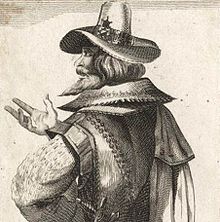The Gunpowder Plot
In February 1604, James introduced harsh measures against Catholics. Not longer after that, the masterminds behind the Gunpowder Plot went to work.
Catesby found willing co-conspirators in Thomas Wintour and John Wright (who had joined Catesby in the 1601 rebellion against the Queen). Several sources say that the men were discussing a plan to blow up the House of Lords as early as 1604. One of the men who went on Catesby's secret trip to Spain to try to convince the king to invade was a soldier named Guy Fawkes. Wintour and Fawkes had fought for Spain against England in the Netherlands. Fawkes was soon onboard. Next to join was Thomas Percy, a friend of Catesby who was also a brother-in-law to John Wright. The plotters then got together in May 1604 and went to work.
Coming on board in October 1604 was Robert Keyes, a noble who had had enough of the king's persecution of Catholics, and Thomas Bates, Catesby's servant who was admitted to the plotting after he discovered it unwittingly. Part 3 |
|
Social Studies for Kids
copyright 2002–2024
David White



 Acknowledged as the leader of the Plot was Robert Catesby (right), who had taken part in a plot against Queen Elizabeth in 1601, in part because his father had been persecuted by the Queen for refusing to agree to join the Church of England and. In 1603, Catesby sought support for the Catholic cause from
Acknowledged as the leader of the Plot was Robert Catesby (right), who had taken part in a plot against Queen Elizabeth in 1601, in part because his father had been persecuted by the Queen for refusing to agree to join the Church of England and. In 1603, Catesby sought support for the Catholic cause from  The number of conspirators grew. Other men to join the plot were Robert Wintour, a brother of Thomas Wintour and cousin of Robert Catesby and a former soldier; John Grant, a brother-in-law of Thomas Wintour and the architect of an adjunct to the Gunpowder Plot, a planned armed uprising in the Midlands; and Christopher Wright, brother of John Wright. (Christopher Wright had taken part in the 1601 rebellion against the Queen and had also accompanied Fawkes to Spain in the attempt to convince Spain to invade England again.)
The number of conspirators grew. Other men to join the plot were Robert Wintour, a brother of Thomas Wintour and cousin of Robert Catesby and a former soldier; John Grant, a brother-in-law of Thomas Wintour and the architect of an adjunct to the Gunpowder Plot, a planned armed uprising in the Midlands; and Christopher Wright, brother of John Wright. (Christopher Wright had taken part in the 1601 rebellion against the Queen and had also accompanied Fawkes to Spain in the attempt to convince Spain to invade England again.)
